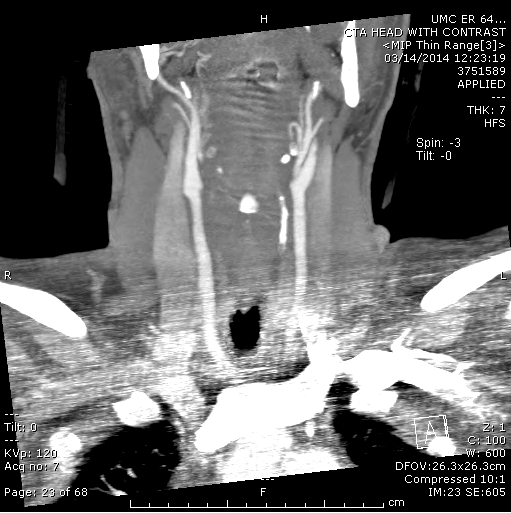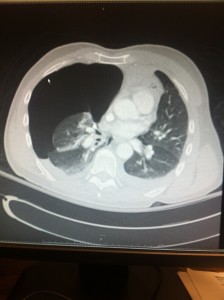Case #2:
30 yo F h/o morbid obesity and DM2 not well controlled on insulin and metformin presents after high speed MVA vs pole. 5 month old baby in back carseat sent the the Ped’s ED, unharmed. EMS called, prolonged extrication about 30 min, vitals en route stable, BP 120/76 and HR 96 just PTA (hmm?). No IVs established, axox3, talking, calm and cooperative.
On exam, breath sounds normal, seat belt sign obvious on lower abdomen with mild LUQ abdominal tenderness on exam, main c/o left thigh pain. Appears twisted but unsure if broken. Patient is morbidly obese, probably 350-400 lbs, which causes some problems next: placed on the monitor and HR 130, check pulses and does have pulses in distal extremities though weak, BP unable to get multiple times, then manual BP unable to obtain. Ask nurse why no BP, states “cuff not big enough to work properly,” also trying on leg.
IV placed in right AC no problem, placed NS on pressure bag. HR during xrays comes down from 130–>115.
CXR done nothing obvious, PXR done, again nothing obvious and left femur show proximal 3rd shaft fx, traction splint placed by intern, FAST scan neg in cardiac window, but very positive in pelvic window as well and slightly positive in RUQ and LUQ. Level 1 called after FAST and finally a BP obtained 80/40 as trauma walks in the door!!! Patient no longer with palpable peripheral pulses, good central pulses, a&ox3.
Ever feel like an idiot…just watched this lady with HR 130 and BP 80/40 for 18 minutes prior to level 1 trauma call!
Blood, central line, another peripheral IV. Trauma dawdled a little in ED more than should have, repeated the very positive FAST scan, though we did resuscitate her with blood and fluids, central line, trauma attempted a-line (apparently they didn’t trust the very low BP either) and finally went to CT scanner (another 25 min) and thought to have SMV avulsion (yikes) prior to taking her to the OR.
Diagnosis: avulsion of superior mesenteric artery (even worse). left femur fracture.
Patient spent more than one month in the SICU, never extubated, multiple loops of bowel resected for necrosis and never closed her abdomen, family decided to withdraw care after she continued to go downhill and quality of life would have been an issue.
Let me point out the obvious, I should have called a level 1 earlier. 10 min earlier when had HR in 130s and unable to obtain BP x 2 would have been enough. Unsure if her outcome would have been different, but sure makes me wonder.
Often times it is hard to get a BP on a morbidly obese person, esp when have peripheral pulses and axox3, but it is much better to be safe than sorry, call the level 1 when in doubt. Better for the patient’s sake to feel like an idiot earlier than to feel like an idiot later in the game.
The other thing is, we had her packaged for the OR when trauma arrived, peripheral IV and blood obtained, 1L fluids, HR 110, CXR, PXR and femur, traction splint to femur, FAST done and very positive. Should have gone straight to the OR as soon as trauma arrived. Trauma fellow wanted CT scan and further resuscitation (why try an a-line?) which took time.
Feedback and comments appreciated.
![Room9er ["Room Niner"]:](https://room9er.com/wp-content/uploads/2020/03/cropped-Screen-Shot-2020-03-08-at-3.16.16-PM.png)

